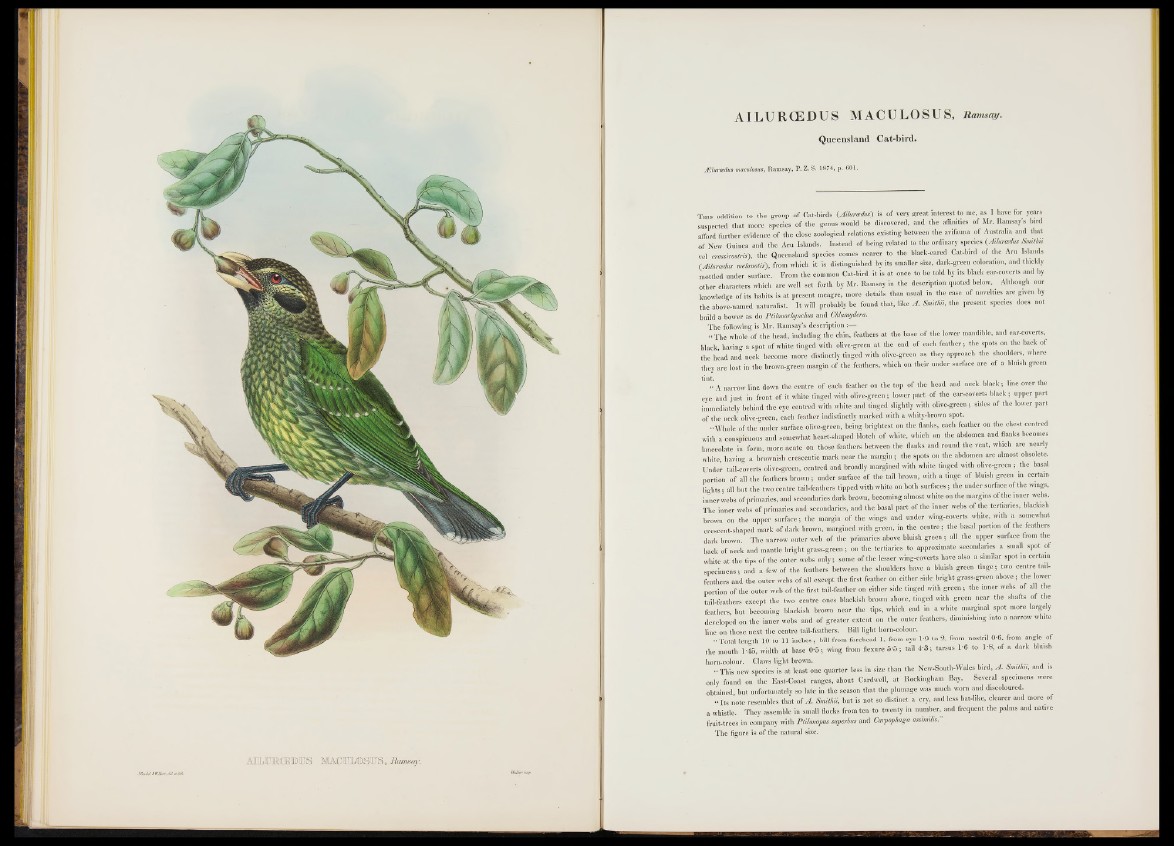
AILURCEDUS MACULOSUS, Ramsay.
Queensland Cat-bird.
JElurce&us maculosus, Ramsay, P. Z. S. 1874, p. 601.
T h is addition to the group of Cat-birds {Ailmxdus) is o f very great interest to me, as I have for years
suspected that more species o f the genus would be discovered, and the affinities of Mr. Ramsay’s bird
afford further evidence of the dose zoological relations existing between the avifauna of Australia and that
of New Guinea and the Aru Islands. Instead o f being related to the ordinary species Smithii
vel cramrostm) , the Queensland species comes nearer to the black-eared Cat-bird of the Aru Islands
(Aih ra sim melanotis), from which it is distinguished by its smaller size, dark-green coloration, and thickly
mottled under surface. From the common Cat-bird it is at once to be told by its black ear-coverts and by
other characters which are well set forth by Mr. Ramsay in the description quoted below. Although our
knowledge of its habits is at present meagre, more details than usual in the case of novelties are given by
the above-named naturalist. It will probably he found that, like A . Smithii, the present species does not
build a bower as do Ptilonorhynchus and Chlamydera.
The following is Mr. Ramsay’s description:—
“ The whole o f the head, including the chin, feathers at the base of the lower mandible, and ear-coverts,
black, having a spot of white tinged with olive-green at the end of each feather; the spots on the back of
the head and neck become more distinctly tinged with olive-green as they approach the shoulders, where
they are lost in the brown-green margin of the feathers, which on their under surface are of a bluish green
“ A narrow line down the centre o f each feather on the top of the head and neck black ; line over the
eye and just in front of it white tinged with olive-green ; lower part of the ear-coverts black I upper part
immediately behind the eye centred with white and tinged slightly with olive-green; sides of the lower part
o f the neck olive-green, each feather indistinctly marked with a whity-brown spot.
“Whole of the under surface olive-green, being brightest on the flanks, each feather on the chest centred
with a conspicuous and somewhat heart-shaped blotch o f white, which on the abdomen and flanks becomes
lanceolate in form, more acute on those feathers between the flanks and round the vent, which are nearly
white having a brownish crescentic mark near the margin ; the spots on the abdomen are almost obsolete.
Under tail-coverts olive-green, centred and broadly margined with white tinged with olive-green ; the basal
portion o f all the feathers brown; under surface of the tail brown, with a tinge o f bluish green in certain
lights; all but the two centre tail-feathers tipped with white on both surfaces; the under surface o f the wings,
l in n e r webs of primaries, and secondaries dark brown, becoming almost white on the margins o f the inner webs.
The inner webs o f primaries and secondaries, and the basal part o f the inner webs o f the tertiaries, blackish
brown on the upper surface; the margin o f the wings and under wing-coverts white, with a somewhat
crescent-shaped mark o f dark brown, margined with green, in the centre; the basal portion o f the feathers
dark brown. The narrow outer web o f the primaries above bluish green ; all the upper surface from the
back of neck and mantle bright grass-green ; on the tertiaries to approximate secondaries a small spot of
white at the tips of the outer webs only; some o f the lesser wing-coverts have also a similar spot in certaiu
specimens; and a few o f the feathers between the shoulders have a bluish green tinge; two centre tail-
feathers and the outer webs o f all except the first feather on either side bright grass-green above I the lower
portion of the outer web of the first tail-feather on either side tinged with green; the inner webs of all the
tail-feathers except the two centre ones blackish brown above, tinged with green near the shafts o f the
feathers, but becoming blackish brown near the tips, which end in a white marginal spot more largely
developed on the inner webs and of greater extent on the outer feathers, diminishing into a narrow white
line on those next the centre tail-feathers. Bill light horn-colour.
“ Total length 10 to 11 inches; bill from forehead 1, from eye 1-9 to 2, from nostril 0 ’6, from angle of
the mouth 1'45, width at base 0 -5 ; wing from flexure 5 -5 ; tail 4 -3 ; tarsus 1-6 to T 8, of a dark bluish
horn-colour. Claws light brown. .
I This new species is at least one quarter less in size than the New-South-Wales bird, A . Sm tlki, and is
only found on the East-Coast ranges, about Cardwell, at Rockingham Bay. Several specimens were
obtained, but unfortunately so late in the season that the plumage was much worn and discoloured.
“ Its note resembles that of A . Smithii, but is not so distinct a cry, and less bat-like, clearer and more of
a whistle. They assemble in small flocks from ten to twenty in number, and frequent the palms and native
fruit-trees in company with Ptilmo pm superbw aod Carpophaga assimilis.”
The figure is of the natural size.